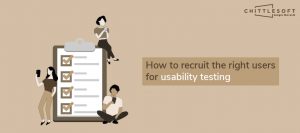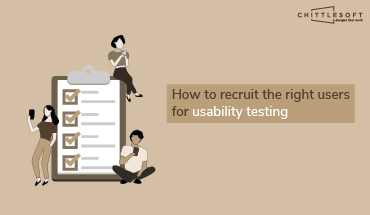
Many companies are known to skip usability testing on UX design for the challenge of finding the right people to perform the test. Sure enough, the specifics of the user for the particular test may not be common. For example, not everyone is a student in the age range of 18–21 familiar with the food delivery app that you are designing and want to take to the next level by introducing a chat feature with the delivery person or restaurant. But the effort that goes into screening individuals for a usability test results in a more evolved design that works for both experienced and inexperienced users, and improves conversion rates.
A Nielsen study reveals that 5 participants in a usability test are enough to highlight the most critical UX design issues. This means that the cost of testing can be limited so long as you find the right individuals to perform the test, and to this end, here are some tips from Chittlesoft.
Criteria for choosing participants for a usability test
1. Use screening questions to include the right demographic.
A series of multiple choice questions, which should not have any “yes” or “no” questions but questions with more specific answers (even if it is “other”) allows you to find the right user for the job.
a. Shortlist users representative of your target group.
In addition to matching the age, gender, income level, and so on required for the test, these users should specifically be facing the problem you are trying to solve. For example, if you want to test the chat feature on your food delivery app, find users who possibly hate talking on the phone.
b. Include users both familiar (niche features) and unfamiliar (general features) with your product.
For example, the niche feature of your product is users’ ability to chat with delivery guys or restaurants through your app, and the general features are the ease of use of the app regardless of age or education. The former improves current users’ user experience and the latter caters to potential users for whom the product can bring a massive change in their daily lives.
2. Factor in accessibility.
People with disabilities (such as visually challenged individuals) should also be able to interact with the design. So when creating such features, recruit individuals who can test them effectively.
3. Avoid including users who work in a field related to the design you are testing.
For instance, avoid including designers who may have a similar skill set as yours and match the demographic you are looking for. They may recommend changes in product design based on their knowledge of how the design should be and not as how the general user may interact with the design. This can result in a biased view.
4. For iterative testing, recruit new users for each test.
You want to see how a new user interacts with multiple layers of the design. Participants from previous tests may become familiar with the design and may overcome the challenges they experienced earlier quicker, thereby coloring the results of your test.
Finding the right users improves usability testing of UI/UX designs significantly because it provides an insight into exactly what glitches need to be resolved at the users’ end. Our designers at Chittlesoft are experienced in creating logical designs based on with powerful user research usability testing methods for your business. Give us a call today and let’s discuss your UI/UX design needs.


